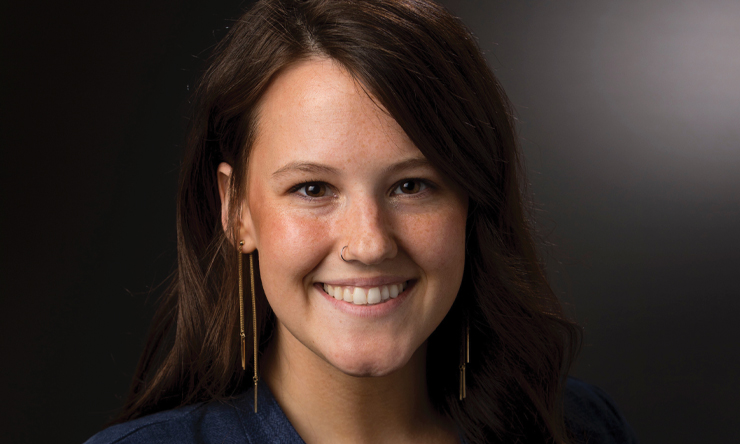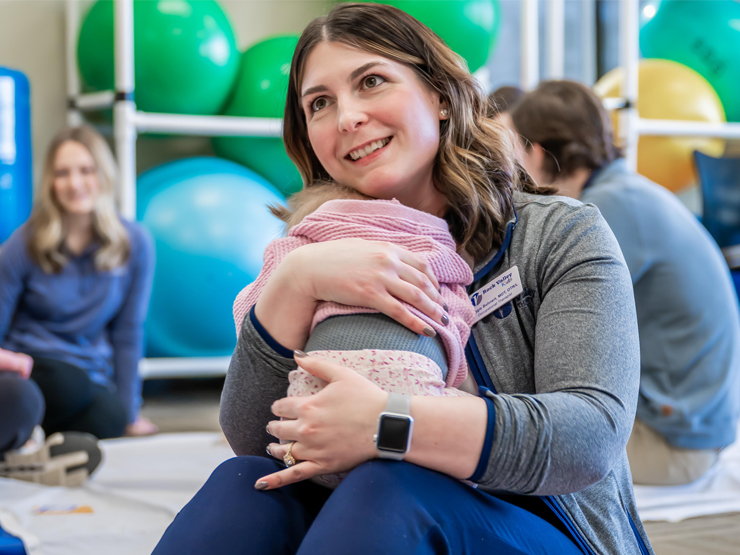It's Sunday night, and Justin Ball is preparing for his theology class tomorrow.
The St. Ambrose senior from Canton, Ill., isn't holed up in a carrel at the library and there's not a pencil or notebook in sight. Instead, the 21-year-old is nestled in a cushy chair in his townhouse, Sudbrook C, his stocking feet propped on a desk equipped with a Hewlett-Packard computer fully-loaded with a CD/DVD player, digital camera and Web cam. Oh, and two monitors. A few feet away, roommate Cory Varcho, a senior from Eldridge, Iowa, multi-tasks on his computer, writing a research paper while downloading MP3s of the Dave Matthews Band.
It's safe to assume that Justin and Cory are among the more tech-savvy students at St. Ambrose. Both are computer and information sciences majors and work in the university's information technology department. But they are quickly becoming St. Ambrose's typical student, whose happiness and success at college, both in and out of the classroom, hinges upon technology.
And for higher education, it's become a matter of survival. Faced with changing student demographics and mounting fiscal pressures, universities nationwide must compete fiercely for high-quality students. Focusing on technology is a way for these institutions to meet these challenges while enhancing not only their teaching but their services to consumer-savvy Generation Y-ers.
A room with Yahoo
Network access plays an especially crucial role in students' satisfaction with a college. At St. Ambrose, every residence hall is wired with high-speed Internet connections, with more than 70 percent of on-campus students having a computer in their dorm rooms.
"We're always checking email, instant-messaging friends, doing research for a class or looking up a homework assignment on an online syllabus," Justin says.
Matt Hansen, residence life director, echoes Justin's sentiment, saying that the does-my-residence-hall-have-Ethernet-in-the-rooms question is one of the most commonly asked by incoming students. "It makes a difference with them," he says.
With that access comes Web-based services such as the Beeline, which has virtually dispensed with the once grueling registration ritual of schlepping back and forth across campus to add or drop a class. Now, SAU students can search for and add or drop courses from the comfort of their own computers. And after registering, they can click on the university bookstore Web site to order textbooks online.
A university's technological resources are just as critical in attracting students. Stella Herzig, reference librarian at O'Keefe Library, says that today's students tend to look to the Internet first for electronic resources and information, rather than going to traditional print mediums. "So it's very important for the library to make its resources available to students in such a format," she says.
St. Ambrose students can check out laptops and use them for any Web activity, including accessing one of the 75 scholarly electronic databases and thousands of professional journals the library has made available online, or by surfing O'Keefe's "Best Information on the Net."
"There's a lot of junk on the Internet," Herzig says. "What we've tried to do is provide students with resources from credible, reliable Web sites."
Yet having a connected student body and comprehensive support services are only part of the "IT" factor. Faculty also need to be well versed in "best practice" uses for technology teaching.
All enlightening, all the time
"Today, students expect professors to use technology to enhance their learning experience," says Lori Rodrigues-Fisher, vice president of academic affairs. "While technological services may not be the deciding factor in a student's final college choice, I think entering students have high expectations of our academic environment, so they also bring with them high expectations of our technological capabilities."
This year, technology has been incorporated at different levels into more than 55 courses across St. Ambrose's three Colleges to mesh with the demands of their disciplines.
One example is assistant professor Rose Hasenmiller's Management of Nursing course. Last semester, the class actually had two forums for meeting: one in a classroom twice weekly, and another that met online 24/7 via an electronic discussion board.
After most classes, Hasenmiller would post a question inspired by the day's lecture. In their own time, students logged on to the site and responded, either directly to the question or to other responses, or offered their own musings on the subject.
"The following class meeting, the students picked up way beyond where they left off the prior week as a result of the electronic discussion," says Hasenmiller. More importantly, "Their writing was often well thought out and authentic, driven by student interest rather than faculty expectation." She adds that use of the discussion board is unquestionably an extension of the classroom that adds value, and it allows her to devote her real class time to teaching new material.
"Lectures don't always allow much time for thinking about your responses," agrees Stefanie Peterson, a sophomore nursing student from Bellevue, Iowa. "With the discussion board, there is a sense that the class is ongoing. And the process is innovative, bringing ideas that I'm not even aware of during class time."
Jill Jacobson, with St. Ambrose's Center for Instructional Design and Technology, says marrying in-class dynamics with a cyber-forum provides students with a more satisfying and challenging educational experience.
"It used to be that at a designated time and place class met, the professor lectured, student interest was piqued and discussions began to inspire new ideas," Jacobson explains. When the class ended, however, the excitement waned and learning slowed.
"This technology fills the void of discontinuity in traditional classes," she says.
The software application, called Blackboard, also allows faculty to maintain virtually all course administration-from syllabuses to grades-online. Students can obtain up-to-the-minute course announcements, assignments and electronic reading materials from any computer on- or off-campus.
Moving at the speed of learning
Although advances in technology continue to move at a breakneck pace, it's incumbent upon higher education, even more than primary or secondary schools, to remain on the leading edge of learning, if graduates are to be equipped to hit the ground running. This means not only improving their educational opportunities, but also giving them choices in technological resources that allow them to use those resources creatively. And in the not-to-distant future, St. Ambrose will need to look more to alternative delivery options, including distance education, to serve those students juggling school, career and family, both in the Quad City region and beyond. With such growth comes an increased demand for online services such as tuition billing and payment.
Although a daunting task, St. Ambrose is up to the challenge, says Rodrigues-Fisher. "We are continuing to discover new and improved ways to do what we do," she says, "and we are uncovering possibilities never before imagined.
News
Share This Story



